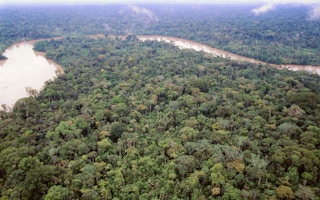Scientists think there is growing evidence to show that the Amazon forest is less effective at absorbing carbon dioxide than previously thought. Instead, they say, it may often be releasing huge quantities of CO2 to the atmosphere, acting not as a carbon sink but as a source.
Their reasons for this potentially significant rethink were published in two reports in the journal Nature. The first describes the results of researchers who sampled the amount of carbon in the air at four points over the Amazon, to build up a more comprehensive picture of the forest’s response to both light and water.
Starting at up to 4.4 kms above the Earth, the researchers’ aircraft collected 17 samples at each point and analysed them for concentrations of five different gases: CO2, methane, nitrous oxide, carbon monoxide and sulphur hexafluoride. They did this in 2010, a year marked by severe drought in Amazonia, and in 2011, which had above-average rainfall.
The drought, obviously, reduced plant production and limited the amount of carbon stored in vegetation, while at the same time large amounts of carbon were released by fire during the dry year. But in 2011 the region was effectively carbon-neutral, experiencing reduced carbon loss from fires and increased carbon uptake by vegetation.
“
The lack of rainfall modifies the dynamics of the forest and the carbon balance in the region. Therefore… precipitation is a factor that scientists working with climate forecasting will have to take into consideration in their models. If not, the results will be very far from reality
Luciana Vanni Gatti, researcher from Brazil’s Nuclear Energy Research Institute
The website Science for Brazil says: “The vegetation managed to absorb not only all the CO2 emitted through natural processes but also the emissions resulting from human activities, including fires.”
‘Far from reality’
The researchers found that the burning of vegetation linked to land use and a reduction in photosynthesis (the process used by plants and other organisms to convert light into chemical energy) meant about 0.48 petagrams (one petagram equals 1,000,000,000,000,000 grams) of carbon were lost from the forest in 2010, against 2011′s carbon neutrality.
As temperatures were similar in both years they say that it was a lack of moisture that lowered photosynthesis rates, not greater heat. Their conclusion is that what the forest really needs is enough water. So the effects of drought and fire together can combine to make the forest a carbon source, not a sink.
The main author of the study is Luciana Vanni Gatti of Brazil’s Nuclear Energy Research Institute (IPEN). She said: “…the lack of rainfall modifies the dynamics of the forest and the carbon balance in the region. Therefore… precipitation is a factor that scientists working with climate forecasting will have to take into consideration in their models. If not, the results will be very far from reality.”
If she and her colleagues are right, and if other forest regions react in the same way, the global consequences could prompt a drastic revision of the forests’ ability to moderate global warming.
Not so green
Support for her team’s conclusions comes in another Nature report, this time dealing with an apparent flaw in one of the reasons why scientists had believed the Amazon forest remained healthy during droughts.
They believed this because the forest appeared green. So, they concluded, it must be absorbing carbon dioxide. But Douglas Morton of the NASA Goddard Space Flight Center and colleagues say the apparent greenness was what Nature calls “an optical artefact of the observation method”.
Satellite measurements in 2003 appeared to show that the Amazon canopy grew more strongly during a drought. As New Scientist reported, young leaves are greener – and reflect more infra-red light – than old foliage, so scientists assumed this was evidence that rainforests grew better during dry years.
It reports that Morton’s team used alternative sensing methods to show that during droughts “NASA’s sensors were not seeing a greener canopy at all. It was a trick of the light – perhaps because fresh foliage growth casts more shadows in the canopy and so absorbs more infrared light”.
Morton told New Scientist: “Seasonal moisture availability governs the balance between photosynthesis and respiration in Amazon forests.” In other words, it concludes, rainforests thrive in the rain. And water availability, rather than light, is the main driver of plant productivity in Amazon forests.










